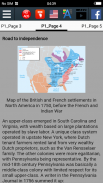








History of the United States of America

คำอธิบายของHistory of the United States of America
The date of the start of the history of the United States is a subject of constant debate among historians. Older textbooks start with the arrival of Christopher Columbus in 1492 and emphasize the European background, or they start around 1600 and emphasize the American frontier. In recent decades American schools and universities typically have shifted back in time to include more on the colonial period and much more on the prehistory of the Native peoples.
Indigenous people lived in what is now the United States for thousands of years before European colonists began to arrive, mostly from England, after 1600. The Spanish had small settlements in Florida and the Southwest, and the French along the Mississippi River and the Gulf Coast. By the 1770s, thirteen British colonies contained two and a half million people along the Atlantic coast east of the Appalachian Mountains.
In the 1760s the British government imposed a series of new taxes while rejecting the American argument that any new taxes had to be approved by the people (see Stamp Act 1765). Tax resistance, especially the Boston Tea Party (1774), led to punitive laws (the Intolerable Acts) by Parliament designed to end self-government in Massachusetts. American Patriots (as they called themselves) adhered to a political ideology called republicanism that emphasized civic duty, virtue, and opposition to corruption, fancy luxuries and aristocracy.
วันของการเริ่มต้นของประวัติศาสตร์ของประเทศสหรัฐอเมริกาที่เป็นเรื่องของการอภิปรายอย่างต่อเนื่องในหมู่นักประวัติศาสตร์ ตำราเก่าเริ่มต้นด้วยการมาถึงของคริสโคลัมบัสใน 1492 และเน้นพื้นหลังยุโรปหรือพวกเขาเริ่มต้นประมาณ 1,600 และเน้นชายแดนอเมริกัน ในทศวรรษที่ผ่านมาโรงเรียนอเมริกันและมหาวิทยาลัยมักจะได้เลื่อนกลับในเวลาที่จะรวมเพิ่มเติมเกี่ยวกับยุคอาณานิคมและมากขึ้นในประวัติศาสตร์ของชนพื้นเมือง
คนพื้นเมืองที่อาศัยอยู่ในตอนนี้ก็คือประเทศสหรัฐอเมริกาเป็นเวลานับพันปีก่อนอาณานิคมยุโรปเริ่มประสบความสำเร็จส่วนใหญ่มาจากประเทศอังกฤษหลังจากที่ 1600 สเปนมีการตั้งถิ่นฐานเล็ก ๆ ในฟลอริด้าและภาคตะวันตกเฉียงใต้และฝรั่งเศสตามแม่น้ำมิสซิสซิปปีและชายฝั่งอ่าวไทย . โดยยุค 1770 สิบสามอาณานิคมของอังกฤษมีสองและครึ่งล้านคนตามแนวชายฝั่งมหาสมุทรแอตแลนติกทางตะวันออกของเทือกเขา Appalachian
ในยุค 1760 รัฐบาลอังกฤษกำหนดชุดของภาษีใหม่ในขณะที่ปฏิเสธอาร์กิวเมนต์อเมริกันว่าภาษีใหม่ ๆ จะต้องได้รับอนุมัติจากผู้คน (ดูตราพระราชบัญญัติ 1765) ต้านทานภาษีโดยเฉพาะอย่างยิ่งงานเลี้ยงน้ำชาบอสตัน (1774) นำไปสู่การลงโทษตามกฎหมาย (การกระทำ Intolerable) โดยรัฐสภาได้รับการออกแบบที่จะยุติการปกครองตนเองในแมสซาชูเซต รักชาติอเมริกัน (ตามที่พวกเขาเรียกตัวเองว่า) ยึดติดกับอุดมการณ์ทางการเมืองที่เรียกว่าปับที่เน้นหน้าที่ของพลเมืองคุณธรรมและการต่อต้านการทุจริตฟุ่มเฟือยแฟนซีและชนชั้นสูง























